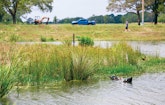
Jose Banderas and Elder Arana from Serco Construction Group move a 3-inch water pump from Lance Rentals to remove stormwater from a Clear Lake City Water Authority construction site.
When golfers lost interest in playing the greens and fairways of Clear Lake (Texas) Golf Course in the early 2000s, its owner looked to sell the Houston-area property for redevelopment. That would have been par for a course, but the Clear Lake City Water Authority had other...











